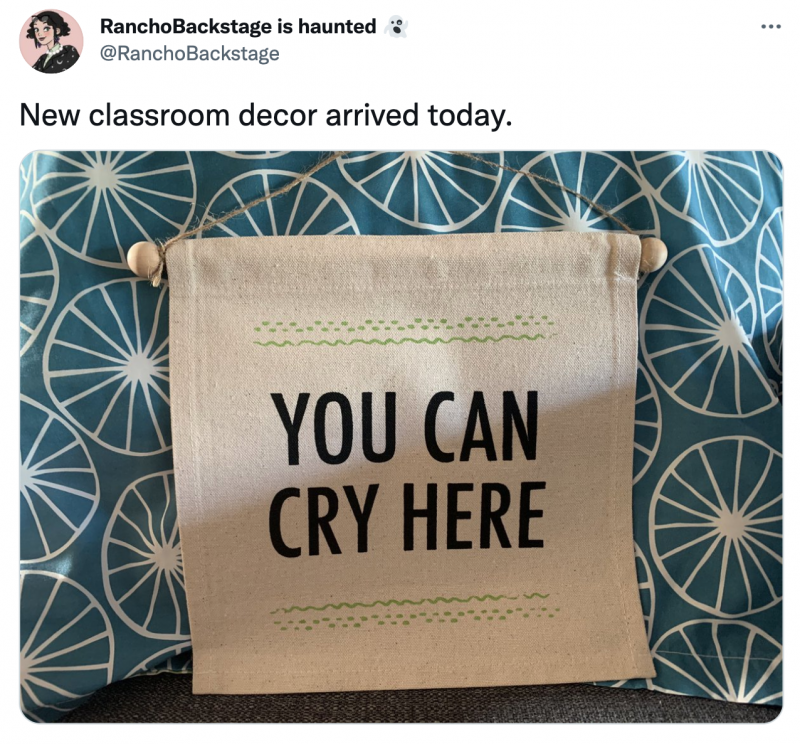In Calote’s classes, students spend a lot of time in character. But when they’re not performing, she wants them to feel safe just being themselves. To encourage that, Calote tries to model it. She participates in warm-up games, shares parts of her life from beyond school, and, perhaps most importantly, she’s honest about her emotions, both the highs and the lows. “You have to have boundaries,” Calote says, but she advocates “being generous with the things that you can so that (students) can feel safe being generous and compassionate with each other.”
That kind of openness is not the norm, according to Patricia Jennings, a University of Virginia researcher who studies teacher stress and how it affects the social emotional context of the classroom. Jennings said that our modern education system tends to view teachers “as people who are always sweet and wonderful and nice and kind and engaged.” But that ideal is impossible to maintain 100% of the time. “Of course, we as teachers all have feelings. And so what happens is teachers suppress those uncomfortable feelings.”
Suppressing negative emotions isn’t good for anyone, Jennings said. It just makes stress worse. The coronavirus pandemic has brought that reality into focus for educators. Over the past year and half, teachers have described the heavy burden of worrying about their students’ academic progress and their own health while being asked to embody a constant “we can do this!” spirit in the face of frequent changes.
For Calote, being truthful about the challenges has been the only realistic way to survive the rollercoaster of uncertainty — and help her students do the same. While many teachers have contemplated quitting during the pandemic, Calote’s approach has helped her reaffirm that she belongs in the classroom.
Seeing the tears
One of the nadirs for Calote’s advanced theater class came in early April. Throughout the prior summer and fall, the veteran teacher put a lot of effort into learning the ropes of digital theater. In the spring, her students dove into creating a show that they could perform on Zoom. They decided to do two versions of the murder mystery Clue — one traditional and one with a modern twist. In both versions, the audience would be able to visit different virtual rooms and make choices that affected the story.
It was exciting. It was innovative. “What you are doing is not being done in most places in the world,” Calote told the young thespians.
But then, after months of adapting to a new artistic form, Calote received an unexpected email from the superintendent. The coronavirus vaccine was rolling out across the country. Pressure to reopen school buildings was mounting. Calote’s superintendent wrote that district teachers would be mandated to return to school buildings within a few weeks.
The news sent Calote reeling. She worried for own health. She worried for her students who weren’t old enough to be vaccinated. And she quickly realized that their plans for Clue would be untenable in the new arrangement.
Because Calote’s classroom at Rancho Campana has no windows, her principal said the school would place air scrubbers near the door. Those machines are loud. Students who remained virtual would hear a sound like a constant ocean wave when Calote or her in-person students spoke into their microphones. Even those in the classroom would have a hard time hearing each other through the noise and masks. The interactive Zoom show they’d been planning could not go on.
Calote’s voice shook as she broke the news to her students over Zoom. “Sorry, I’m trying to like, stay calm. My heart is beating really fast right now,” she said. As she spoke, students sent her messages like, “I’m so sorry you have to go in like this. It’s unfair,” and “It’s OK, Ms. Calote, you’ve done so much for us.” Seeing the messages, Calote’s tears spilled over. She reached for a tissue and wiped her eyes. Then she promised students that she’d find new, safe ways for them to perform and create. “It’ll, it’ll be fine,” she said. “I know it doesn’t look like it right now because I’m kind of a mess. But, you know, it’s very shocking and pretty new.”
In a moment like this, many teachers might have tried to hide their tears until they were off camera or students left the room. But that’s not always possible.
“When you’re in a classroom with a bunch of students and you’re all basically captive in this room, you can’t leave,” said Jennings, the UVA professor. “When your emotions get the best of you, you have to manage them in front of everybody. You have no privacy.”
Is it OK for teachers to cry in class? Jennings said it’s a difficult question to answer, and it depends. But when a teacher and her students are facing a major disappointment like Calote’s class was, “being honest makes a lot of sense. … I’m sure (crying is) not your first go-to in any given situation. But when it happens, I think it’s OK.”
Permission to feel
Calote hadn’t expected to cry that day, but she didn’t feel bad about it either. “I just did the best I could, and I knew that it’s safe to be expressive and truthful with that particular group. I didn’t need to act and put on, like, a brave face,” she said. After all, she’d been honest all year long about how the pandemic was affecting her, in hopes that students would feel comfortable doing the same.


